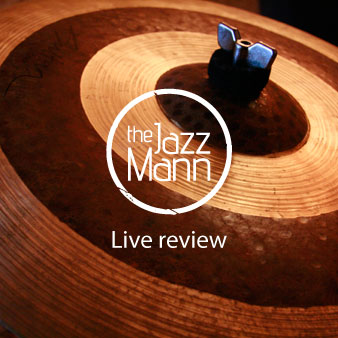
by Tim Owen
January 30, 2009
/ LIVE
Hopefully it won't be another two years before we see this world class trio in action again
Julian Siegel (tenor saxophone, bass clarinet, clarinet), Joey Baron (drums); Greg Cohen (double bass)
Julian Siegel is one of the stalwarts of the domestic jazz scene, most often seen fronting the Partisans. Tonight was his second consecutive date at the Vortex as the leader of this world-class trio, convened - for the first time since it was recorded here two years ago - to launch their excellent new album, ?Live at the Vortex’.
Whereas the Vortex regularly hosts Siegel, London audiences rarely get an opportunity to see either Joey Baron or Greg Cohen at such close quarters. Both are busy men, perhaps best known in tandem as the bedrock of John Zorn’s original Masada quartet; Cohen has also been a key presence in Ornette Coleman’s recent ensembles.
Although the forceful, rhythmic orientation of the Partisans may make them the ensemble more likely to appeal to a crossover audience, this trio setting enables Siegel to exercise greater subtlety in his approach to his main instrument, the tenor sax, and to spotlight his talents as a composer.
Of tonight’s two main sets, the first - in its elegant, understated brilliance - bought to my mind the live recordings of Joe Henderson’s ?State of the Tenor’ trio. Unlike Henderson’s elegant refinement of the dominant full-bodied approach to the tenor sax, however, Siegel’s sound is predominantly clear and fluent, with knotty twists and dissonant interjections keeping the listener on their toes. His tonal range is broad but always harnessed to the melodic development of the current idea. His compositions may not be immediately hummable, indeed they take time to develop melodically, but they are lyrical, even mellifluous.
Each set featured a mix of new material and pieces now familiar from the album. The first began with a feature for Baron, followed by a swinging, relaxed number in which the tempo was tweaked to accommodate melodic variations on the theme. Baron maintained the rhythm while concentrating on his kit’s rims and cymbals while Cohen kept solid time with a consistently deft touch. The next piece featured a bass clarinet solo, with Siegel smearing notes in an unusual way before taking off over a stealthy, grounded rhythm. Wigsworld swung harder, with Cohen digging particularly deep and Baron keeping things fast and light, almost implying the rhythm. Throughout the set, Siegel favoured a conversational style with short, breath-long phrases.
The second was more expansive and varied in tone. Opening with a new number titled Seven Days, Siegel was blowing harder, the melody more knotty, the rhythm more powerful; but it was the following Haunted Waltz that opened things up comprehensively. Starting with Siegel blowing both tenor and clarinet simultaneously to produce eerie tones, the group quickly segue into a peppy march, somewhat reminiscent of the peppier sections of Charles Ives’ Three Place in New England. Siegel initially concentrated on clarinet, then picked up the bass clarinet again, as the trio took us through a number of digressions and variations, including a hands-only solo by Baron, before the piece resolved into a steady mid-tempo rhythm.
A new number with a strong tenor sax solo preceded a fine rendition of Charles Mingus’ Duke Ellington’s Sound of Love, and the stop/start refrain of an original composition titled Sandpit - an intricate piece that makes oblique reference to the sound of New York’s downtown scene. Two contrasting encores were by turns tentative and subtly Latinate. On the latter, the harder Siegel blew the more relaxed the others sounded.
Throughout the evening the New Yorkers breathed life into Siegel’s music, with Baron in particular clearly delighting in every moment. Hopefully that means it won’t be another two years before we hear this trio in action again.
blog comments powered by Disqus